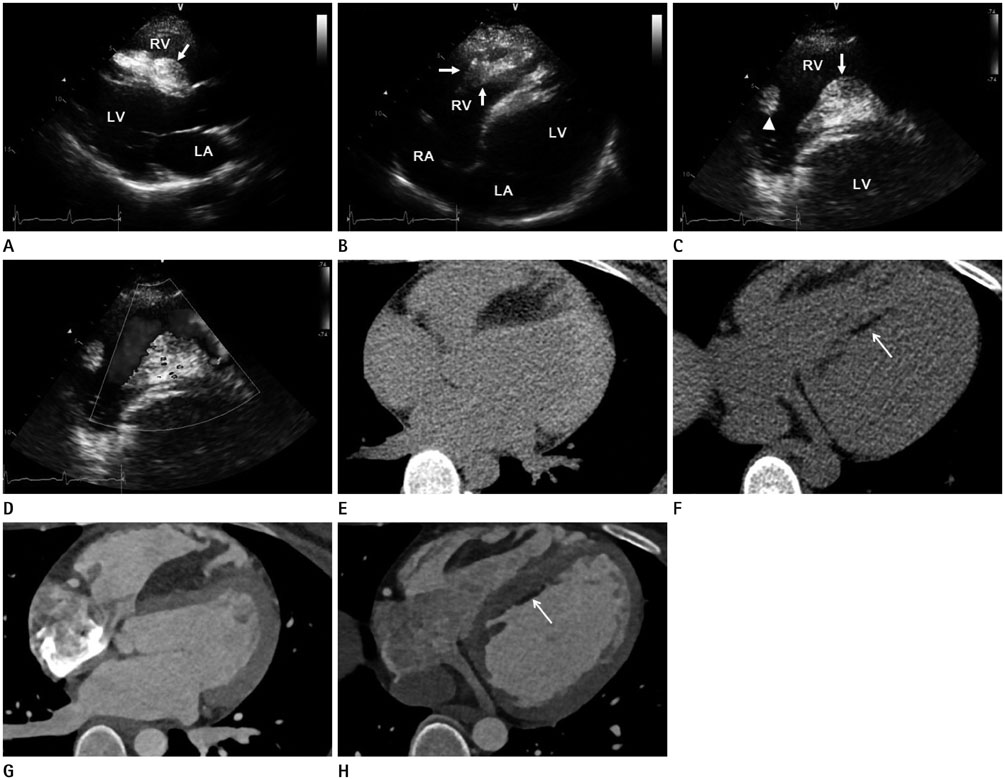J Korean Soc Radiol.
2015 Apr;72(4):250-254. 10.3348/jksr.2015.72.4.250.
Right Ventricular Lipomatous Mass and Biventricular Multifocal Fat in a Young Woman: A Case Report
- Affiliations
-
- 1Department of Radiology, Chungnam National University Hospital, Chungnam National University School of Medicine, Daejeon, Korea. haneul88@hanmail.net
- 2Division of Cardiology, Department of Internal Medicine, Chungnam National University Hospital, Chungnam National University School of Medicine, Daejeon, Korea.
- KMID: 1941755
- DOI: http://doi.org/10.3348/jksr.2015.72.4.250
Abstract
- Cardiac lipoma is a rare neoplasm of encapsulated mature adult adipose tissue. It is usually asymptomatic, but it may be related to hemodynamic obstruction depending on its location. We report a typical case of right ventricular lipomatous mass and multifocal fat infiltration of both ventricles, which were detected incidentally in a young woman.
Figure
Reference
-
1. Roberts WC. Primary and secondary neoplasms of the heart. Am J Cardiol. 1997; 80:671–682.2. Rajiah P, To AC, Tan CD, Schoenhagen P. Multimodality imaging of an unusual case of right ventricular lipoma. Circulation. 2011; 124:1897–1898.3. Araoz PA, Mulvagh SL, Tazelaar HD, Julsrud PR, Breen JF. CT and MR imaging of benign primary cardiac neoplasms with echocardiographic correlation. Radiographics. 2000; 20:1303–1319.4. Sanal HT, Kocaogğlu M, Yildirim D, Ors F. Multiple cardiac lipomas and pericardial lipomatosis: multidedector-row computer tomography findings. Int J Cardiovasc Imaging. 2007; 23:655–658.5. Marcus FI, McKenna WJ, Sherrill D, Basso C, Bauce B, Bluemke DA, et al. Diagnosis of arrhythmogenic right ventricular cardiomyopathy/dysplasia: proposed modification of the task force criteria. Circulation. 2010; 121:1533–1541.6. Tuna IC, Julsrud PR, Click RL, Tazelaar HD, Bresnahan DR, Danielson GK. Tissue characterization of an unusual right atrial mass by magnetic resonance imaging. Mayo Clin Proc. 1991; 66:498–501.7. Carpenter HM. Myocardial fat infiltration. Am Heart J. 1962; 63:491–496.8. Kim SS, Ko SM, Song MG. Linear fat deposition in the middle layer of the left ventricular myocardium: computed tomographic findings. Korean J Radiol. 2010; 11:571–573.9. Araoz PA, Eklund HE, Welch TJ, Breen JF. CT and MR imaging of primary cardiac malignancies. Radiographics. 1999; 19:1421–1434.10. Kimura F, Matsuo Y, Nakajima T, Nishikawa T, Kawamura S, Sannohe S, et al. Myocardial fat at cardiac imaging: how can we differentiate pathologic from physiologic fatty infiltration? Radiographics. 2010; 30:1587–1602.
- Full Text Links
- Actions
-
Cited
- CITED
-
- Close
- Share
- Similar articles
-
- A Case of Epicardial Lipomatous Hypertrophy: A Mimicker of Pericardial Mass
- A Rare Case of Lipomatous Hypertrophy of the Interventricular Septum
- Biventricular Hypertrophic Cardiomyopathy with Severe Right Ventricular Outflow Track Obstruction
- A Case of Lipomatous Neurofibroma
- Cutaneous Lipomatous Neurofibroma on the Lower Leg: A Case Report


